Argentina 2015 "Argentina in
Antarctica:
50th Anniversary of Operation 90 and Argentina scientists: first
dinosaurs’ discovery in Antarctica"
| <prev | back to index | next> |
| Issue Date | 09.03.2015 |
| ID | Michel: 3601, Bl. 145 (3602-3603); Scott: 2758, 2759a-b; Stanley Gibbons: 3605, ; Yvert: 3071, ; Category: pF |
| Designer | Evangelina Raffaelli, Philatelic Department, Correo Oficial de la Republica Argentina SA |
| Stamps in set | 3 |
| Value |
$6 - Antarctopelta oliverois $11 - photo of Colonel Jorge Edgard Leaö, Commander of Operation 90 $14 - picture of Argentine Army crew that reached the South Pole |
| Emission/Type | commemorative |
| Issue place | Buenos Aires |
| Size (width x height) |
$6 - 44mm x 34mm $11, $14 - 60mm x 30mm MS 100mm x 150mm |
| Layout | Mini-Sheet of 2 stamps: $11 and $14 $6 - Sheet of 20 |
| Products | FDC x 2 |
| Paper | |
| Perforation | 14 |
| Print Technique | offset, four colours, metalized ink |
| Printed by | Letra Viva SA, Buenos Aires |
| Quantity | $6 20.000, MS of 2 20.000, FDC 3.000 each |
| Issuing Authority | Correo Oficial de la Republica Argentina SA |
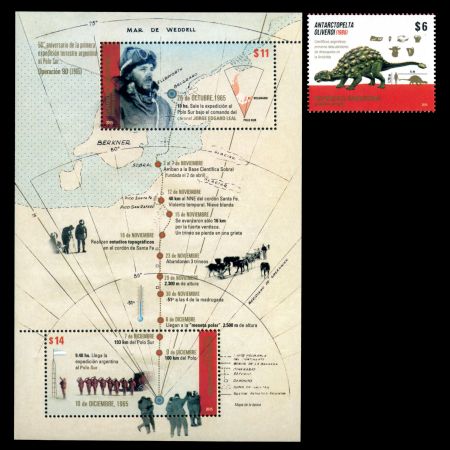
On March 9, 2015, Argentinian Post released the set of 3 stamps: one Mini-Sheet with two stamps and one single stamp. As distinguished from the 2014 stamps, this time the prehistoric animal was depicted on a single stamp instead of as part of a mini-sheet.
The single stamp shows Antarctopelta oliverois, dinosaur found by Argentinian scientists.
In 1986, an expedition from Argentine Antarctic Institute to James Ross island found remains of unknown dinosaur species. It is a genus of ankylosaurian dinosaur represented by a single species, A. oliveroi, which lived at the end of the Cretaceous period (about 75 million years ago) in the Campanian, nowadays Antarctica.
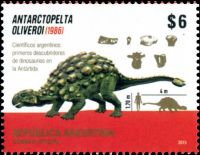
|
| Antarctopelta oliverois on stamp of Argentina 2015, MiNr.: 3601, Scott: 2758 |
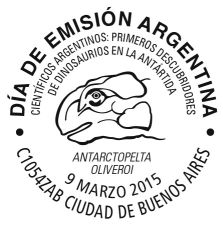
|
| Antarctopelta oliverois on postmark of Argentina 2015 |
Teeth, parts of the lower jaw, fragments of a skull, vertebrae, limb and toe bones, posterior part of a tail and hip and numerous pieces of the shield of the Antarctopelta were found. The material was collected in a 6 m2 area during several seasons, and all of it is considered to be part of a single individual.
Among Ankylosauria the Antarctopelta was medium sized, about 4 mts long. It was a solid herbivorous, quadruped, protected by armor plates inserted in the skin and with small but well ossified skull. From the found vertebrae, belonging to several parts of the tail, ossified tendons at the superior and inferior sides of that organ can be assumed.
In Ankylosauria this tendon helped to keep straight the end of the tail, topped with a big bonny club. It is probable for the Antarctopelta to have had a similar club. These fossils are the only ones known of this Ankylosauria, which despite being the first dinosaur discovered in Antarctica was the second one to be formally named, next to the Crylophosaurus in 1994. Antarctopelta was named in 2006 by Argentine paleontologists Salgado and Gasparini.
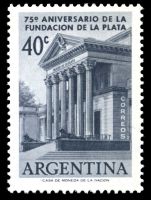 |
| La Plata Natural Sciences Museum on stamp of Argentina 1958, MiNr.: 667, Scott: 670. |
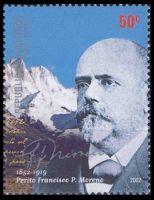 |
| Dr. Francisco Pascasio Moreno on stamp of Argentina 2002, MiNr.: 2720, Scott: 2186b |
The Antarctopelta oliveroi’s remains are on display in the La Plata Natural Sciences Museum, ceded by the Antarctic National Management for its care and exposure.
The La Plata Natural Sciences Museum, built in 1884, is one of the oldest Natural History Museums in South America. The collection of the Vertebrates Paleontological Division (DPV) was created in 1877, when Dr. Francisco Pascasio Moreno, who was a director of the museum later on, donated 15.000 pieces. Beside this original bone, several Argentine and Antarctic dinosaur materials have been collected, acquired during more than a century and kept in the collection of the DVP. These contain thirteen types of materials and other important specimens of dinosaur, including ornithischians (ornithopods, ankylosaurs), saurischians (theropod, saurophodomorpha) and three ichnospecies.
The background of the Souvenir-Sheet, (MiNr.: Bl. 145, stamps - 3602-3603; Scott: 2759a-b), shows a map indicating Antarctic section's zone where in 1965, Operation 90 (First Argentine Land Expedition to the South Pole) took place.
On the map, the course (from Base Belgrano to South Pole) is marked and in orange, the expedition's places and significant dates.
Further, there is also a picture of the three researchers performing topographic studies, a thermometer indicating record temperature during that course and a picture of sledges and polar dogs.
In 1965. Argentine Army men decided to reach for the first time the South Pole, via land from the General Belgrano Base, located at 77° 46' South latitude and -38° 11‘ West longitude, on the Filchner Barrier.
The expedition began on October 26"‘ going on a very difficult road. where the deep crevasses and sastrugi (furrows that the wind digs on the ice surface) thus forcing them to a slow, difficult and very risky march.
At 83° South latitude they required a two-day pause to repair the sledges. That was the most difficult time of the trip, to which men referred as ‘Desolation camp‘.
On December 10"‘ -after a 4 days march and doing the last trek without sleeping for 28 hours- the expeditionary set foot on the Pole‘s hardened snow and on the last day of the year, December 31" 1965, after working their way for approximately 2900 km on the polar ice cap for 66 days, climbing to heights of over 3.000 metres at temperatures below -40°, the group returned to Belgrano base. The feat had been accomplished.
More details about Operation 90 expedition is here.
Products and associated philatelic items
| Sheet of the dinosaur stamps | FDC and commemorative covers, used for FDC | |
 |
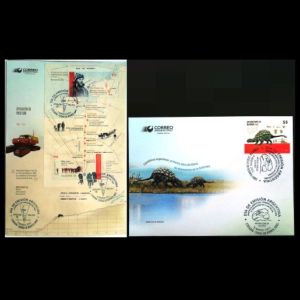 |
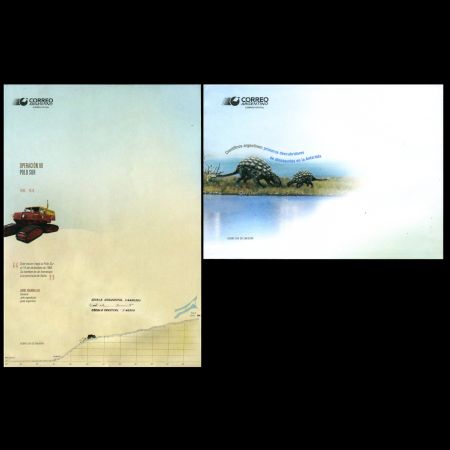 |
| Circulated FDC | Example of Circulated Covers | |
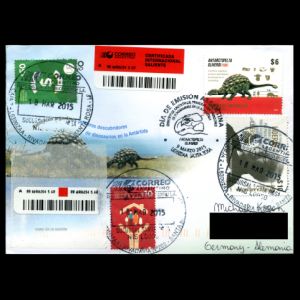 |
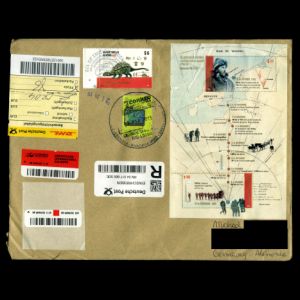 |
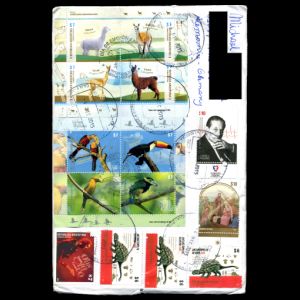 |
| Circulated FDC with the Mini-Sheet is here | Registered and regular covers sent to Germany | |
| Booklet with stamps descriptions (PDF) | First-Day-of-Issue Postmarks | |
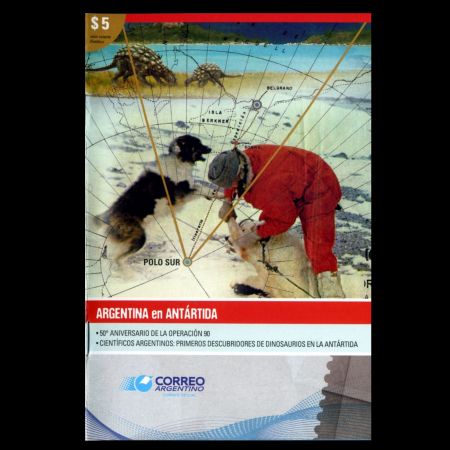 |
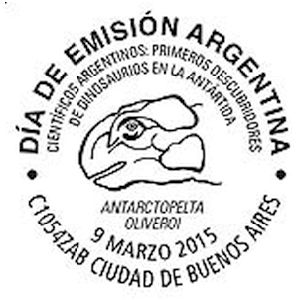 |
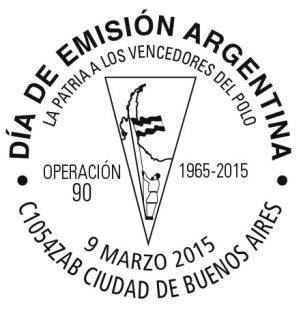 |
References:

|
Acknowledgements:
- Many thanks to Dr. Peter Voice from Department of Geological and Environmental Sciences, Western Michigan University, for the draft page review and his very valuable comments.
- Many thanks to fellow stamp collector Mrs. Romina Aimar and her husband from Argentina, for their help translating the stamp booklet.
| <prev | back to index | next> |